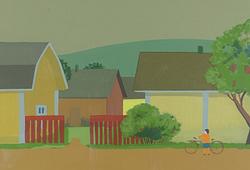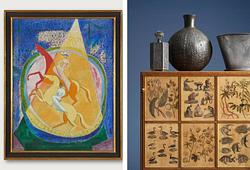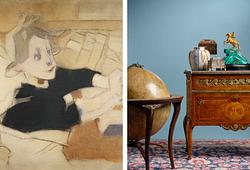Anders Zorn
"Fröken Amelie Coyet"
Signed Zorn and dated 1919. Oil on canvas 125 x 80 cm.
Provenance
Previously in the collections at Torup Castle, Bara parish, Skåne
Exhibitions
Liljevalchs konsthall, Stockholm, "Bruno Liljefors - Anders Zorn", 10 April - 25 April 1920, cat. no 93.
Literature
Tor Hedberg, 'Anders Zorn', par 2, 1924, mentioned p. 154 illustrated p. 153.
Gerda Boëthius, 'Zorn'. Tecknaren. Målaren. Etsaren. Skulptören', 1949, mentioned p. 514, listed in the catalogue under the year 1919.
More information
‘Fröken Amelie Coyet’ from 1919 is an example of what is often referred to as Anders Zorn's ultima maniera - his last period. Zorn finds a new expression in his paintings from the early 20th century onwards, where one finds the broad brushstrokes and the reduced contour sharpness of his earlier periods, but also sees a new simplicity of expression with a more concentrated colouring and greater restraint in form.
Gerda Boëthius wrote of the portrait: ‘Young Miss Amelie Coyet, heiress to Torup, stands girlishly young against the light grey wall of the studio, and he has made a symphony of colour in grey-blue of her clothing and the background, while the family pearls lie white against her blonde neck. It is a masterly psychological portrayal of a young woman who has not yet been liberated, and who carries within her passion, power and will.’
Artist
Anders Zorn, born in Mora in 1860, showed artistic talent from a young age. In 1875, he traveled to Stockholm and became a student at the then Slöjdskolan (now Tekniska högskolan) in Stockholm, and shortly after, he joined the Royal Academy of Fine Arts. Initially, Zorn had aspirations of becoming a sculptor, but soon watercolor painting took over, becoming his primary medium until 1887. At the student exhibition in 1880, Zorn had his breakthrough with the watercolor painting "I sorg." The following year, he gained international acclaim as a portrait painter. His watercolor painting reached its pinnacle during this period, and his most famous work from this time is "Vårt dagliga bröd” from 1886. Shortly thereafter, Zorn transitioned to oil painting, which was met with immediate success. Zorn's reputation mainly rested on his portrait art, and he portrayed many notable figures, including presidents. For instance, he created an etching of Theodore Roosevelt. His etchings significantly contributed to his success. In the late 1880s, Zorn began working in the genre that would increasingly become his trademark: nude figures in outdoor settings. He had long been fascinated by the movement of water and the reflections of light on its surface. Now, he added the complexity of placing a model near or in the water, aiming to depict a synthesis between nature and humanity. In 1896, Zorn and his wife moved back to Sweden and settled in Zorngården in Mora. This move sparked a renewed interest in his homeland, which would be reflected in his future paintings. Among the artist's scenes from the Mora region, portraying its local customs and ancient traditions, "Midsommardansen" holds the highest value according to Zorn himself. Today, the painting can be found at the National Museum.
Read more















































